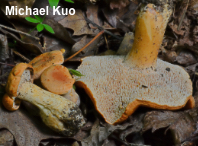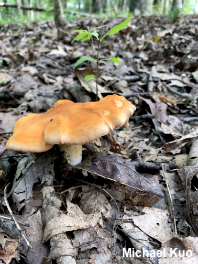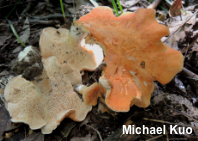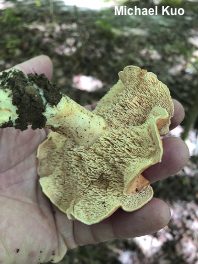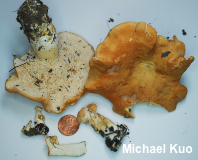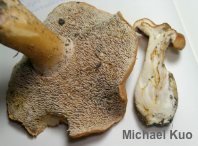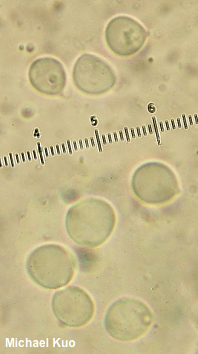| Major Groups > Toothed Mushrooms > Hydnum > Hydnum aerostatisporum |

|
Hydnum aerostatisporum [ Basidiomycota > Cantharellales > Hydnaceae > Hydnum ... ] by Michael Kuo Large and orange, with a stem that often darkens with age, Hydnum aerostatisporum is apparently common and widely distributed east of the Rocky Mountains in hardwood or mixed forests. It was originally described from Texas, but has since been documented in the Midwest, the southeastern United States, and Québec. It is one of several similar eastern North American species that are apparently less common and have more limited distribution (see Swenie and collaborators 2018). Under the microscope, Hydnum aerostatisporum has fat spores with tiny apiculi, leading to the Latin species name, since the authors of the species (Buyck and collaborators 2017) thought the spores looked like hot air balloons (aerostati-sporum = airship-spore). Hydnum subrufescens is a synonym, representing European semicolonialist taxonomy based on touristic collections made by Europeans visiting North America—who then neglected to study other, previous European semicolonialist taxonomy based on touristic collections made by Europeans visiting North America. I don't know if you can tell this, but I'm kinda sick of European mycologists trying to establish and describe North American species based on a few collections made on their vacations. (That said, I should add that many North American mycologists do basically the same thing to Central America, South America, and Africa . . . maybe I need to write an essay called "Mycocolonialism," and start with Linnaeus.) Description: Ecology: Mycorrhizal, probably with oaks and other hardwoods; recorded in various ecosystems, including hardwood and mixed hardwood-conifer forests; growing gregariously on the ground; summer and fall; widely distributed east of the Rocky Mountains. The illustrated and described collections are from Illinois. Cap: 3.5–13 cm wide; broadly convex, becoming planoconvex, flat, or shallowly centrally depressed; dry; bald, but often becoming cracked and subscaly with age; pastel orange when young, becoming orange to brownish orange; the margin becoming wavy and broadly lobed with age. Undersurface: Not running down the stem, or just beginning to do so; covered with densely packed, soft spines that are round in cross-section and measure 2–6 mm long; creamy to pale orangish; not bruising. Stem: 3–8 cm long; 2–3 cm thick; equal; dry; bald; pale orangish when young, but often becoming darker brownish orange with maturity; bruising brownish orange; sometimes with a whitish sheen or whitish patches in places. Flesh: Whitish; sometimes slowly orangish or brownish when sliced; brittle. Odor and Taste: Sweetish, not distinctive. Chemical Reactions: Ammonia flashing pink, then resolving to negative on cap surface. KOH negative on cap surface. Iron salts negative on cap, spines, and stem. Microscopic Features: Spores 6–8.5 x 6–7 µm; subglobose to broadly ellipsoid, with a small apiculus; smooth; hyaline in KOH. Basidia 4-sterigmate; 30–40 x 4–6 µm; subclavate. Pseudocystidia 30–36 x 2–7 µm; cylindric with rounded apices, or occasionally sublageniform; thin-walled; smooth; hyaline or with golden contents in KOH. Pileipellis not clearly differentiated; cap surface hyphae tangled, 3–8 µm wide, hyaline to ochraceous in KOH, with clamp connections. REFERENCES: B. Buyck, D. Lewis & V. Hofstetter, 2017. (Buyck et al., 2017; Niskanen et al., 2018; Swenie et al., 2018.) Herb. Kuo 09289621, 09181403, 08032004. This site contains no information about the edibility or toxicity of mushrooms. |
© MushroomExpert.Com |
|
Cite this page as: Kuo, M. (2020, September). Hydnum aerostatisporum. Retrieved from the MushroomExpert.Com Web site: http://www.mushroomexpert.com/hydnum_aerostatisporum.html |
